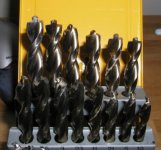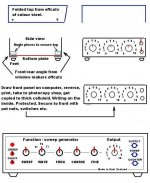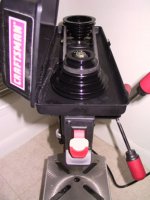Member
Joined 2002
Peter,
I think he said it was around $130 bucks, once I heard the hundred part I lost interest so I don't remember the exact amount. Because I was just playing along and did not think power cable would make such a impact. He switched the cable in the pre-amp, the effect was pretty big right away.
I think he said it was around $130 bucks, once I heard the hundred part I lost interest so I don't remember the exact amount. Because I was just playing along and did not think power cable would make such a impact. He switched the cable in the pre-amp, the effect was pretty big right away.
I would be reluctant to spend that much for power cord. For the amps I'm using the cable which installs in walls for house wiring, solid wire, 12ga from Home Depot.
...a little overboard, perhaps? 😉supply in a transport has CLCLCRCRC filtering
chris ma, here's the pic I promised:
Attachments
Me too Peter, that's why I wasn't really paying much attention to the sales rep at that particular moment, hence don't remember the exact amount.
Chad, thanks for the pix, I've saved it for future reference.
Must go to bed now, got to get up for work in 4 hours,
Later..
Chad, thanks for the pix, I've saved it for future reference.
Must go to bed now, got to get up for work in 4 hours,
Later..
My favourite drill bits are the ones from DeWalt (or Black & Decker) and available at HD. They are piloted, so drilling large, centered holes is not a problem. Just start with a smaller size and step up. For instance, I do 1/2" diameter hole in two steps. First I drill the hole for 1/2" drill bit pilot, then use the 1/2" drill bit and drill it through.
Those drill bits are also perfect for doing recessed holes for flush mounting of the Allen screws.
Those drill bits are also perfect for doing recessed holes for flush mounting of the Allen screws.
Attachments
 Oh yeah, those pilot point drills really nice too! I don't think they take care of the wander problem when starting a hole though... they're still long and flexible like other drill bits. But, they do a great job of following a pilot hole so you can gradually step up in size and get a nice, round hole with them.
Oh yeah, those pilot point drills really nice too! I don't think they take care of the wander problem when starting a hole though... they're still long and flexible like other drill bits. But, they do a great job of following a pilot hole so you can gradually step up in size and get a nice, round hole with them.What makes the centre drill special is it's sheer rigidity. It simply will not bend, so the hole goes right where you put the tip of the drill, every time. Even if you start a hole slightly off, leaving a dimple in the wrong place, you can restart the hole 1mm over, and it won't pull back toward the centre of the dimple. Once the shoulder cuts in, it leaves a nice taper that will center whatever size drill you follow it up with (up to 1/4 inch).
More explaination
There are several aluminium window manufacturers in my town and they used to be real friendly but since we now have very strict regulations about members of the public not being allowed to enter manufacturing areas because there have been some nasty accidents my source for cheap offcuts of extrusion dried up for a while.
One company showed me where they rubbish bin is and I can poke through that as long as I ask first and do not wander around.
Their rubbish bin is like a goldmine of all sorts of extrusion offcuts some up to a meter long and in various finish from natural aluminium colour to bronze and a wide range of very colourful powder coat paint jobs. Not much flat sheet but sometimes I am lucky and get a good bit. Usually 1/16th inch thick which I use for the bottom of my chassis's. The top I make out of steel offcuts from the long run roofing people and they have miles of it flat sheet say 12 inches wide x several meters. It is painted at the factory in roof colours and baked and is a very good durable finish and easy to fold between some steel angles in the vice and lean on it with length of timber so as not to give buckles or damage the paint finish.
I use a nut and bolt to hold on the rubber feet and the back/front angle and the chassis bottom and the top cover mounting bracket together. The bolt holes I make little larger than clearance to allow slight adjustment get it all square.
I find cutting alumin very easy in a saw bench with 8 inch 1/8 width blade with tungsten carbide teeth which is also excellent for woodworking. Stays sharp for years and not expensive. Safety glasses are absolutely essential when cutting aluminium
There are several aluminium window manufacturers in my town and they used to be real friendly but since we now have very strict regulations about members of the public not being allowed to enter manufacturing areas because there have been some nasty accidents my source for cheap offcuts of extrusion dried up for a while.
One company showed me where they rubbish bin is and I can poke through that as long as I ask first and do not wander around.
Their rubbish bin is like a goldmine of all sorts of extrusion offcuts some up to a meter long and in various finish from natural aluminium colour to bronze and a wide range of very colourful powder coat paint jobs. Not much flat sheet but sometimes I am lucky and get a good bit. Usually 1/16th inch thick which I use for the bottom of my chassis's. The top I make out of steel offcuts from the long run roofing people and they have miles of it flat sheet say 12 inches wide x several meters. It is painted at the factory in roof colours and baked and is a very good durable finish and easy to fold between some steel angles in the vice and lean on it with length of timber so as not to give buckles or damage the paint finish.
I use a nut and bolt to hold on the rubber feet and the back/front angle and the chassis bottom and the top cover mounting bracket together. The bolt holes I make little larger than clearance to allow slight adjustment get it all square.
I find cutting alumin very easy in a saw bench with 8 inch 1/8 width blade with tungsten carbide teeth which is also excellent for woodworking. Stays sharp for years and not expensive. Safety glasses are absolutely essential when cutting aluminium
Turning a drill press into a milling machine
Further to HifiZen's musing a couple of pages back I've come across these vices in various catalogues (e.g. RS Components).
They have x and y feeds and should be ok for light use. Not sure about the milling cutters though - is there a type suitable for mounting in a conventional three jaw chuck? There are cutters for real milling machines and a Morse Taper No. 2 would fit my drill press. Only problem is that these cost more than the drill press. There must be cheaper milling bits available...
James
Further to HifiZen's musing a couple of pages back I've come across these vices in various catalogues (e.g. RS Components).
They have x and y feeds and should be ok for light use. Not sure about the milling cutters though - is there a type suitable for mounting in a conventional three jaw chuck? There are cutters for real milling machines and a Morse Taper No. 2 would fit my drill press. Only problem is that these cost more than the drill press. There must be cheaper milling bits available...
James
Attachments
Quick tip for drilling PCBs, If your fine drill bit breaks, you can use an ordinary paperclip!
Just cut off one of the straight sides at 45 degrees with a pair of sharp side cutters. As long as you use this in a drill press with a slowish speed, it cuts nice fine holes in paxolin or fibreglass🙂
Just cut off one of the straight sides at 45 degrees with a pair of sharp side cutters. As long as you use this in a drill press with a slowish speed, it cuts nice fine holes in paxolin or fibreglass🙂
dear people
my background is mostly electronics, so don't get blame me for asking this simple questions
what is a router, what is it for?
what is a planar, what is it for?
what the difference between mitre saw and band saw
my background is mostly electronics, so don't get blame me for asking this simple questions
what is a router, what is it for?
what is a planar, what is it for?
what the difference between mitre saw and band saw
Re: Turning a drill press into a milling machine
James!,
I know all of You guys would love to use Your drill presses for makeshift "mini-mills", but remember! Mill spindles have to take lots of side load forces(Look at the "Millhead" on a mill sometime they need big taper bearings in there). Using Your drill press will(At least) subject Your spindle bearings to excessive side loading, and at may well damage them badly. Even if You are using a "Through away" press, the side play might be really bad and ruin Your project. I would suggest using the "Router method" shown in this thread, as routers are made for side loads. Be carefull and Wear Saftey Glasses!
Keep sending in the good ideas everyone! This is great!!!! 😀
Tall Shadow
nemestra said:Further to HifiZen's musing a couple of pages back I've come across these vices in various catalogues (e.g. RS Components).
They have x and y feeds and should be ok for light use. Not sure about the milling cutters though - is there a type suitable for mounting in a conventional three jaw chuck? There are cutters for real milling machines and a Morse Taper No. 2 would fit my drill press. Only problem is that these cost more than the drill press. There must be cheaper milling bits available...
James
James!,
I know all of You guys would love to use Your drill presses for makeshift "mini-mills", but remember! Mill spindles have to take lots of side load forces(Look at the "Millhead" on a mill sometime they need big taper bearings in there). Using Your drill press will(At least) subject Your spindle bearings to excessive side loading, and at may well damage them badly. Even if You are using a "Through away" press, the side play might be really bad and ruin Your project. I would suggest using the "Router method" shown in this thread, as routers are made for side loads. Be carefull and Wear Saftey Glasses!
Keep sending in the good ideas everyone! This is great!!!! 😀
Tall Shadow
Re: Re: Turning a drill press into a milling machine
Totally agree with that 🙂 If there is a stupid idea you can count on me having tried it at some point - I mounted the router cutting bit on the drill press and tried cutting a circle. I was very careful (tried on 1/4" plywood only) and ready to stop immediately if anything went wrong (with a power switch operated by foot, etc.). Nothing much happened though - some vibrations and the chuck fell off.
Bad, bad, bad idea!
Tall Shadow said:
remember! Mill spindles have to take lots of side load forces(Look at the "Millhead" on a mill sometime they need big taper bearings in there). Using Your drill press will(At least) subject Your spindle bearings to excessive side loading, and at may well damage them badly.
Totally agree with that 🙂 If there is a stupid idea you can count on me having tried it at some point - I mounted the router cutting bit on the drill press and tried cutting a circle. I was very careful (tried on 1/4" plywood only) and ready to stop immediately if anything went wrong (with a power switch operated by foot, etc.). Nothing much happened though - some vibrations and the chuck fell off.
Bad, bad, bad idea!
NickC
I did not know all those jargons before, but after a trip to the local hardware store it all became clear. Just ask the salesman. It is rather tedious to explain here.
Good Luck and do pay a visit to your local hardware store.
what is a router, what is it for?
what is a planar, what is it for?
what the difference between mitre saw and band saw
I did not know all those jargons before, but after a trip to the local hardware store it all became clear. Just ask the salesman. It is rather tedious to explain here.
Good Luck and do pay a visit to your local hardware store.
Bob2 said:Jag
You can use your drill press to tap holes. You just have to do it with the press unplugged. Clamp your piece securly in the press, lower the bit into the hole and with your free hand turn the chuck to tapping. I use this method to turn insert nuts into wood, keeps everything straight and aligned.
Bob2
I tried this today, works really well. Instead of turning the chuck, I popped open the top cover and pulled on the pulley belt to turn the tapping bit. Did a lot of 6-32 (Zen4 on way) taps on scrap aluminum and no problems at all 😀
Attachments
a drill press without a bunch of shavings
my youngest son bought me a drill press when he was in high school -- turns out he uses it most of the time (hmmmm, I wonder why he bought it) -- I can';t believe that the picture shows a press without a bunch of aluminum or wood shavings beneath it!
my youngest son bought me a drill press when he was in high school -- turns out he uses it most of the time (hmmmm, I wonder why he bought it) -- I can';t believe that the picture shows a press without a bunch of aluminum or wood shavings beneath it!
- Status
- Not open for further replies.
- Home
- Design & Build
- Equipment & Tools
- Useful tools and techniques





